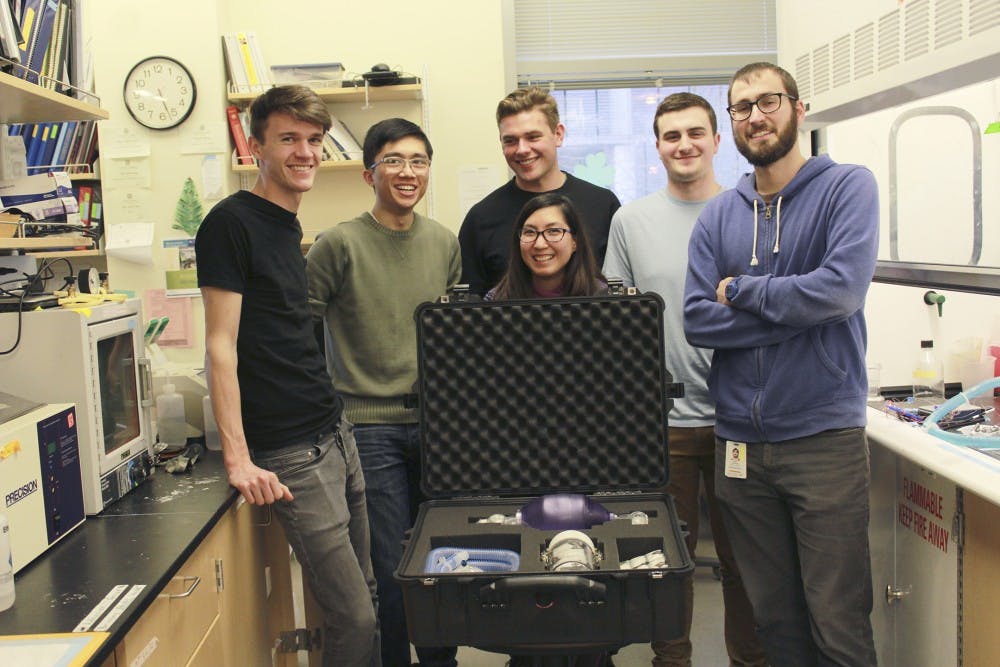Eric Swanson wasn’t planning to be so involved in Bioengineers Without Borders (BWB) when he first joined. Now, as president of the organization, he’s pretty much as involved as he could possibly be.
BWB is a student organization at the University of Washington that focuses on creating medical technologies for places that may not have access to quality health care resources. BWB focuses on creating low-cost, quality medical equipment while also learning skills useful to bioengineering and related career fields. The teams that comprise BWB do consist of many bioenginnering (BIOE) majors or intended majors, but the team is home to members from other fields as well.
There are currently eight active teams in BWB. Swanson is the graduate leader of one team focusing on building a low-cost anesthesia delivery device. The team is built of current undergraduates Philip Walczak, Timmy Lee, Gabby Pang, Conner Pitts, Ajeet Dhaliwal, Ross Boitano, and Kaleb Smith.
The idea for the project came about approximately three years ago when Walczak was taking the “Introduction to Bioengineering Problem Solving” class at the UW. He brought his idea to BWB and wanted to turn it into actual functioning technology people could use.
“There’s this lack of access to basic surgery in low-resource settings and there’s a lot of reasons for that lack of training for anesthesiologists on it,” said Swanson, a bioengineering Ph.D student at the UW. “Another major component is a lot of what is required for surgery [isn’t] available because of the lack of access.”
Along with fellow Ph.D student David Peeler, Swanson has been leading a team to create the anesthetic device. The difference between this medical technology and others available is its portability, which allows doctors to carry it with them for surgery, making it ideal for low-resource settings. Although there are other portable anesthetic devices available, many are not of good quality and can make it a challenge for doctors to apply the accurate doses they need.
Along the way, the BWB team ended up finding and working with BIOE associate professor Wendy Thomas and Anthony Roche, a professor of anesthesiology in the UW School of Public Health. Both have helped advise the team while keeping a hands-off approach to the building of the project itself.
“My role is two-fold,” Thomas explained. “One of my roles is that I provide a lab space, and the other role is that I provide bioengineering expertise and help them to bounce ideas off when it comes to their project and give them feedback.”

The team is currently working on a draw-over vaporizer, one type of portable anesthetic device. A draw-over vaporizer is different than a plenum vaporizer because a plenum version requires a power source to make it functional. If there is a power outage, there is no way to use a plenum vaporizer in an emergency medical situation.
During surgery, the anesthetic chamber that contains the general anesthesia or inhaled anesthesia needs to be kept at a constant temperature. That is a problem for draw-over vaporizers because it’s hard to maintain the constant temperature needed for surgery.
The anesthetic device team recruited UW MBA student Aaron Boswell to help present the project at a business competition, specifically aimed at highlighting how to market the anesthetic device after the project is completed and ready for medical professionals to use. With his help, the team won second place and a grant of $10,000 at the Holloman Health Innovation Challenge on March 3, 2017.
Another BWB team is focusing its efforts on building a hydration monitor, a device that measures hydration levels for communities where people may not be able to diagnose themselves properly. The goal is to create a quality monitor to use in developing countries most in need. The device this team is creating is unique because there is a lack of competitors attempting to address the same issue.

“The focus is on infants and children ages zero to five who cannot speak for themselves, whereas adults can say whether they are dehydrated or not,” co-project manager and BIOE undergraduate Micaela Everitt said.
In addition to Everitt, this team is made up of Annapurni Sriram, Barbie Varghese, Caleb Perez, Devin Garg, Emily Chun, Jocelyn Ma, and Vidhi Singh. BIOE Ph.D student and mentor Hal Holmes serves as an advisor because of the core members who were working on the project at the time. Holmes said he was impressed by their passion and drive for the project, and he has stayed on as the team has added more members to the project.
The faculty advisor for the hydration team is Matthew Bruce, a principal scientist/engineer at the UW’s Applied Physics Laboratory. He aids the team with technical direction and advises them on other mechanical aspects of the project.
“For people in a place without immediate access to healthcare or doctors, they will need to use a device like this to try to diagnose whether or not their child is dehydrated and by how much,” Sriram said.
BWB welcomes anyone who is passionate and willing to learn the skills needed for various projects, and the organization is also currently looking for any upperclassmen in a technology-related major to get involved. The best candidates will be passionate and driven to create technology that can make meaningful change around the globe.








